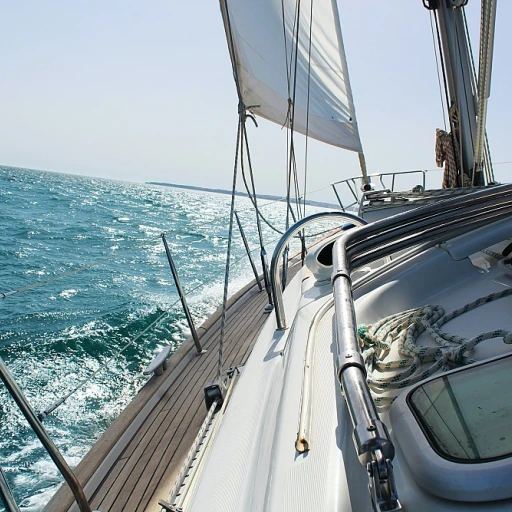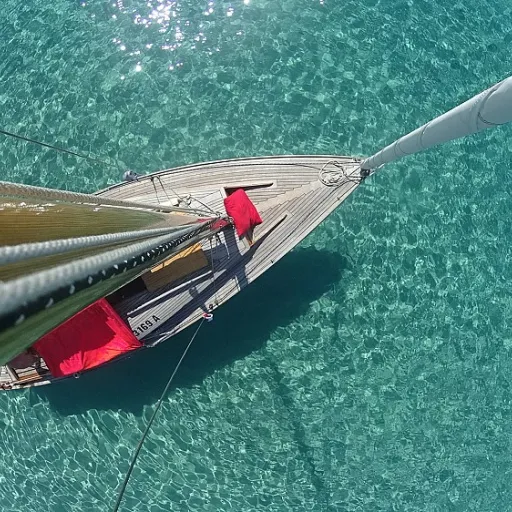
Understanding Dyneema and its role in yachting
Why Dyneema is a Game-Changer in Modern Yacht Rigging
In recent years, Dyneema has become a staple in yacht rigging, celebrated for its impressive strength-to-weight ratio and resistance to abrasion. This synthetic fiber, often found in products like Amsteel Blue, is now the go-to choice for many boat owners and crew members looking to optimize performance and safety on board. Dyneema ropes are used for everything from soft shackles and eye splices to critical load-bearing applications, making them a versatile solution for both cruising and racing yachts.
Key Benefits of Dyneema for Yacht Applications
- Exceptional Strength: Dyneema offers high tensile strength, allowing it to handle significant loads without stretching or breaking. This is crucial for rigging, where reliability is non-negotiable.
- Lightweight Construction: Its low weight reduces overall rigging mass, which can enhance boat speed and handling.
- Low Stretch: Dyneema maintains its shape under load, ensuring consistent performance in dynamic conditions.
- Durability: The fiber resists UV degradation and abrasion, extending the service life of ropes and splices.
Common Dyneema Rope Applications on Board
On yachts, Dyneema is used for halyards, sheets, control lines, and even lifelines. Its ability to be spliced, stitched, or locked into various configurations—such as the brummel splice, lock stitch, or long bury—makes it adaptable for different rigging needs. Whether you’re creating a locked brummel eye splice for a high-load application or using lock stitching to secure a soft shackle, Dyneema’s flexibility is unmatched.
Understanding the Importance of Proper Splicing
The method you choose to join Dyneema ropes—be it a brummel splice, bury splice, or stitching—directly impacts the strength and reliability of your rigging. Each technique, from the classic brummel lock to modern lock eye splices, has its own advantages and limitations. Selecting the right approach depends on factors like load requirements, location on the boat, and ease of inspection or repair. For a deeper dive into related safety considerations, check out this resource on the importance of masthead lights in yacht operations.
As we explore the specifics of brummel splices and stitching methods in the following sections, you’ll gain a clearer understanding of which technique works well for your yacht’s unique needs. The right splice or stitch can make all the difference in maintaining the integrity and safety of your rigging system.
What is a brummel splice and how does it work?
How the Brummel Splice Creates a Secure Lock
The brummel splice is a popular method for joining Dyneema ropes in yacht rigging, especially when a strong, reliable eye splice is needed. This technique is well known for its ability to create a locked connection without the need for additional stitching, making it a favorite among boat owners and crew who value both strength and simplicity. The process involves interweaving the rope back into itself, forming a loop or "eye" at the end. The key feature of the brummel splice is the "brummel lock," which is achieved by passing the rope through itself in a specific sequence. This lock ensures that the splice remains secure under load, even if the rope is not under constant tension. For those working with Amsteel Blue or similar Dyneema lines, the locked brummel technique is often recommended for its reliability.- Locking mechanism: The brummel lock prevents the splice from slipping, even when the rope is unloaded.
- Long bury: After the lock is formed, a section of the rope is buried inside itself to further increase strength and security.
- Eye splices: The resulting eye can be used for attaching shackles, hardware, or other rigging components.
The stitching method explained
How the Stitching Method Secures Dyneema Rope
Stitching is a practical alternative to the brummel splice for joining Dyneema ropes, especially in yacht rigging where flexibility and strength are key. This method is often chosen when a traditional brummel lock or long bury splice is not feasible due to space constraints or when working with thicker lines like Amsteel Blue.
In the stitching process, the rope ends are first buried into each other, similar to a bury splice. The critical step is then to use a strong, abrasion-resistant thread to sew or stitch through both rope sections multiple times. This lock stitch creates a secure bond, preventing the ropes from slipping apart under load. The stitching is typically done in a zigzag or cross pattern, ensuring that the joined location remains locked even under dynamic loads common in yacht applications.
- Lock Stitching: The stitches act as a lock, holding the buried sections together and distributing the load across the splice.
- Eye Splices: Stitching is often used to reinforce eye splices, providing extra security for soft shackles and critical rigging points.
- Adaptability: Works well for both permanent and temporary repairs, making it a favorite among crew members who need quick solutions on board.
Compared to a locked brummel or brummel eye splice, stitching offers more flexibility in terms of rope diameter and location on the boat. However, the strength of the stitched splice depends heavily on the quality of the thread, the number of stitches, and the technique used. Properly executed, a lock stitch can approach the strength of a brummel splice, but improper stitching may lead to slippage or failure under high loads.
For yacht owners and crew, understanding when to use stitching versus a brummel splice is crucial for safe and efficient rigging. For more details on integrating these techniques with your yacht’s control systems, check out this guide on navigating the intricacies of the boat console.
Performance comparison: brummel splice vs stitching
Comparing Strength and Security Under Load
When it comes to Dyneema rigging on a boat, the performance of your splice is critical. The brummel splice, especially when combined with a long bury and a brummel lock, is widely recognized for maintaining a high percentage of the rope’s original strength. This method creates a locked eye that resists slipping under heavy loads, making it a favorite for critical applications like soft shackles and standing rigging. The locked brummel eye splice works well for Amsteel Blue and similar ropes, ensuring the joined sections remain secure even after repeated loading and unloading.
Stitching, on the other hand, relies on lock stitching to secure the bury. While a properly executed lock stitch can provide excellent holding power, the overall strength often depends on the quality and location of the stitches. If the stitches are too close to the eye or not buried deep enough, the splice may slip or lose strength under dynamic loads. However, when combined with a long bury and careful lock stitching, this method can approach the strength of a brummel splice, especially for less critical applications or temporary rigging.
Ease of Inspection and Maintenance
One of the advantages of the brummel splice is its visible lock mechanism. Crew members can quickly check if the splice is still locked and the eye is intact. This visual confirmation is valuable during routine rigging checks, especially when posts or messages in online forums highlight common mistakes like incomplete buries or missed brummel locks.
With stitching, inspection is a bit more nuanced. The stitches can wear over time, especially if exposed to UV or abrasion. Regular checks are necessary to ensure the lock stitch is still holding. Some yacht owners prefer this method for its simplicity, but it does require more frequent attention compared to a locked brummel eye splice.
Suitability for Different Yacht Applications
- Brummel Splice: Ideal for permanent rigging, high-load locations, and when maximum strength retention is needed. Works well for eye splices, soft shackles, and any application where the rope member is under constant tension.
- Stitching: Suitable for temporary solutions, quick repairs, or when a full brummel lock is not practical due to rope size or location. Also useful for bury splices where a traditional brummel cannot be performed.
Both methods have their place in the yacht industry. The choice often comes down to the specific load requirements, the type of Dyneema rope, and the experience of the crew or rigger. For those sharing their experiences in log register posts or forum messages, the consensus is clear: for critical, high-load rigging, a locked brummel splice with a long bury offers the most reliable performance, while lock stitching provides a flexible alternative for less demanding situations.
Practical considerations for yacht owners and crew
Choosing the Right Splice for Your Boat
When deciding between a brummel splice and stitching for Dyneema rigging, yacht owners and crew need to weigh several practical factors. The location of the splice on the boat, the type of load it will bear, and the skill level of the member performing the splice all play a role in the final decision.- Load and Strength: Brummel splices, especially when locked (locked brummel), are known for maintaining a high percentage of the rope's original strength. This makes them ideal for high-load applications like halyards, soft shackles, and critical rigging points. Stitching, particularly lock stitching, can also provide a secure join, but may not match the strength retention of a well-executed brummel lock.
- Ease of Inspection: Eye splices and brummel splices are easier to inspect visually for integrity. Stitching can sometimes hide issues beneath the surface, especially if the bury is long or the rope is heavily loaded.
- Time and Tools: Stitching requires a needle and thread, and some experience with lock stitch techniques. Brummel splices, especially the brummel eye or splice brummel, need careful attention to detail but can be performed with basic splicing tools. Amsteel Blue and other Dyneema ropes respond well to both methods, but the brummel method can be more forgiving for beginners.
- Space and Application: In tight locations or where a compact eye is needed, a brummel eye splice works well. For longer runs or where a bury splice is possible, both methods are viable, but the long bury technique with a lock stitch can add extra security.
Common Mistakes and How to Avoid Them
- Insufficient Bury: Not burying enough rope after the splice or stitch can compromise strength. Always follow manufacturer guidelines for minimum bury length.
- Forgetting the Lock: Whether using a brummel lock or lock stitching, omitting the locking step can lead to slippage under load. Double-check that the lock is secure before putting the rope into service.
- Poor Stitching Technique: Uneven or loose stitches reduce the effectiveness of the join. Practice on spare rope and review posts or log register entries from trusted rigging forums for tips.
- Ignoring Rope Condition: Dyneema is strong but can degrade over time. Inspect the rope for wear before splicing, and replace any member joined with visible damage.
Tips from Experienced Crew
- Always test a new splice under controlled load before relying on it in critical rigging.
- Keep detailed messages or notes about each splice, including the method used and the location on the boat. This helps with future maintenance and troubleshooting.
- For eye splices and soft shackles, a locked brummel or a well-executed lock stitch can provide peace of mind.
- Click expand on reputable rigging guides or forums to see step-by-step visuals and advice from experienced members.
Expert insights and common mistakes to avoid
Expert Advice on Achieving Reliable Splices
When working with Dyneema on your boat, attention to detail is crucial for both safety and performance. Experienced rigging professionals consistently highlight a few key points when choosing between a brummel splice and stitching methods.- Locking is essential: Whether you opt for a brummel splice, lock stitch, or a combination, the lock is what prevents the splice from slipping under load. A locked brummel or a lock eye splice offers extra security, especially in high-load rigging applications.
- Long bury for strength: The bury length—the section of rope tucked inside itself—directly impacts the strength of the splice. A long bury is recommended for both brummel and stitched splices, particularly with Amsteel Blue or similar high-performance ropes.
- Stitching as a backup: Many riggers add lock stitching to a brummel splice for added peace of mind. This is especially common in soft shackles and eye splices, where the stitch acts as a secondary lock.
Common Pitfalls and How to Avoid Them
- Incorrect location of the lock: Placing the lock too close to the eye or not burying enough rope can compromise the splice. Always follow manufacturer guidelines for bury length and lock placement.
- Inconsistent tension during splicing: Uneven tension can lead to weak spots. Take your time to ensure the rope is evenly tensioned as you bury and lock the strands.
- Overlooking rope condition: Old or damaged Dyneema loses strength. Always inspect the rope before starting a splice or stitch, and avoid using worn sections for critical rigging.













